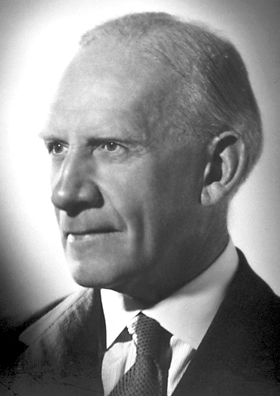Robert Robinson (chemist) facts for kids
Quick facts for kids
Robert Robinson
|
|
|---|---|
 |
|
| 48th President of the Royal Society | |
| In office 1945–1950 |
|
| Preceded by | Sir Henry Hallett Dale |
| Succeeded by | Edgar Adrian |
| Personal details | |
| Born | 13 September 1886 Derbyshire, England |
| Died | 8 February 1975 (aged 88) Great Missenden, Buckinghamshire, England |
| Alma mater | University of Manchester |
| Known for | Development of Organic synthesis Arrow pushing Biomimetic synthesis Cholesterol total synthesis Tropinone Robinson annulation Robinson–Gabriel synthesis Allan–Robinson reaction |
| Spouse(s) | Gertrude Maud Robinson |
| Awards | Longstaff Prize (1927) Davy Medal (1930) Royal Medal (1932) Copley Medal (1942) Nobel Prize for Chemistry (1947) Franklin Medal (1947) Albert Medal (1947) Faraday Lectureship Prize (1947) |
| Scientific career | |
| Fields | Organic chemistry |
| Institutions | University of Sydney University of Liverpool British Dyestuffs Corporation University of Manchester University College London University of Oxford |
| Doctoral advisor | William Henry Perkin, Jr. |
| Doctoral students | Sir Edward Abraham Arthur John Birch William Sage Rapson John Cornforth Rita Harradence K. Venkataraman |
Sir Robert Robinson (born September 13, 1886 – died February 8, 1975) was a very important British organic chemist. He won the Nobel Prize for Chemistry in 1947. He was recognized for his amazing work on plant colors, called anthocyanins, and natural compounds known as alkaloids. In the same year, he also received the Medal of Freedom with Silver Palm.
Contents
A Life of Discovery
Early Life and Education
Robert Robinson was born in 1886 at Rufford House Farm, near Chesterfield, England. His father, James Bradbury Robinson, made surgical dressings.
Robert went to school at Chesterfield Grammar School. He also attended the private Fulneck School. He loved chemistry and studied it at the University of Manchester. He earned his first degree there in 1905. In 1907, he received a special research scholarship. This allowed him to continue his studies at the University of Manchester.
A Career in Chemistry
In 1912, Robert Robinson became the first professor of organic chemistry at the University of Sydney in Australia. He later taught at several other famous universities. These included St Andrews University (1920–1922) and Manchester University.
In 1928, he moved to University College London. After two years, he became a professor at Oxford University in 1930. He also became a Fellow at Magdalen College, Oxford.
His work was so important that he was elected to many international science groups. These included the United States National Academy of Sciences in 1934. He also joined the American Philosophical Society in 1944. In 1948, he became an honorary member of the American Academy of Arts and Sciences.
Several places are named after him to honor his contributions. These include Robinson Close at Oxford. The Robert Robinson Laboratory is at the University of Liverpool. The Sir Robert Robinson Laboratory of Organic Chemistry is at the University of Manchester. The Robinson and Cornforth Laboratories are at the University of Sydney.
Beyond the Lab: Chess
Sir Robert Robinson was also a very good amateur chess player. He even played for Oxford University in a match in 1944. He was the president of the British Chess Federation from 1950 to 1953. He even co-wrote a book about chess called The Art and Science of Chess.
Amazing Discoveries
Creating Complex Molecules
One of his most famous achievements was his synthesis of tropinone in 1917. Tropinone is a building block for important medicines like atropine. This was a huge step in chemistry. It showed how to make complex ring-shaped molecules in a single, simple process. This process is called a one-pot synthesis.
The Benzene Symbol
In 1923, while working at St Andrews University, he came up with a new way to draw benzene. He suggested using a circle in the middle of the hexagon. This symbol is still used today to represent benzene. It helps chemists understand its unique structure.
Other Important Work
Robinson also developed a reaction called the Robinson annulation. This reaction has been very useful in making steroids in the lab. He also worked with Edward Charles Dodds to create diethylstilboestrol. This was an important synthetic hormone.
In 1957, Sir Robert Robinson started a science journal called Tetrahedron. He worked with many other editors to create it. This journal is still very important for sharing new chemistry research.
Family Life
Sir Robert Robinson was married twice. In 1912, he married Gertrude Maud Walsh. After she passed away in 1954, he married Mrs. Stern Sylvia Hillstrom in 1957.
See also
 In Spanish: Robert Robinson para niños
In Spanish: Robert Robinson para niños


